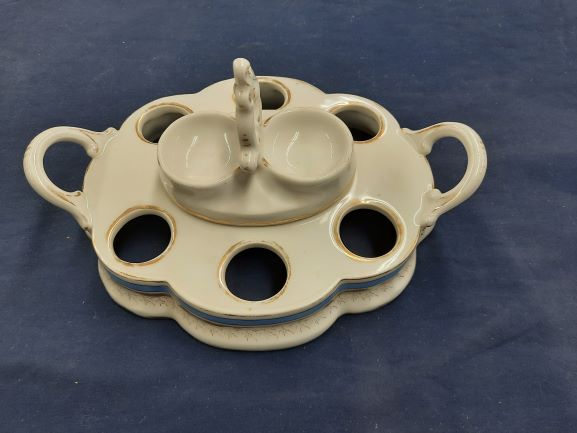
Egg Server
Oval egg server with handles. Comes in two pieces – lower section is white with a blue stripe, and gold gilt decoration – has three holes on each side for the eggs. Top piece is white with gold gilt trim, has a handle and a space for salt and pepper. Pottery stamp is faded, but appears to read as KPM. This pottery mark was in use from 1837 to 1844.KPM is an acronym for K�nigliche Porzellan-Manufaktur Berlin, which translates to �Royal Porcelain Factory in Berlin.� The company was founded in 1763 by Frederick II of Prussia, who bought the factory from its previous owner, Johann Ernst Gotzkowsky, in the wake of its bankruptcy. Frederick II greatly admired the factory�s �white gold,� a type of porcelain so fine and translucent that it closely mirrored the high-quality porcelain made in China. He invested large sums of money into the company and granted it the use of the royal scepter as its emblem. He also commissioned many KPM porcelain objects to be made in the Rococo style for his palace.
Royal Beginnings
From the company�s founding in 1763 to the abdication of Emperor William II in 1918, KPM was owned by seven kings and emperors. KPM porcelain made during this period reflects not only the fashions of the time but also Prussian royal taste. Technological advances during the 1860s led to increasingly modern modes of production and design, but even so, KPM continued to value craftsmanship, and KPM artists devoted time and care to produce unique, handmade objects. The German state began running the company in 1918, upholding its traditions and overseeing the production of contemporary wares and figurines. In 2006, Berlin banker Jorg Woltmann assumed full control of KPM as its sole shareholder, effectively privatizing the historic company. Since then, KPM sales galleries have opened across Germany, and the international market for KPM porcelain has flourished.